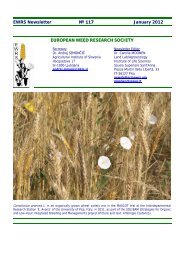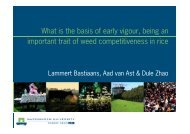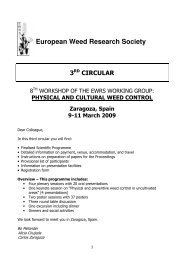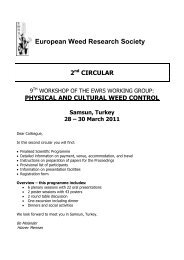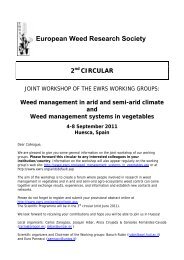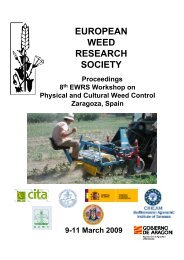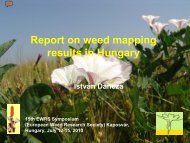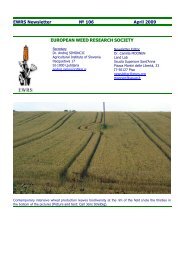Physical and Cultural Weed Control Working Group of - European ...
Physical and Cultural Weed Control Working Group of - European ...
Physical and Cultural Weed Control Working Group of - European ...
Create successful ePaper yourself
Turn your PDF publications into a flip-book with our unique Google optimized e-Paper software.
9 th EWRS Workshop on <strong>Physical</strong> <strong>and</strong> <strong>Cultural</strong> <strong>Weed</strong> <strong>Control</strong> 59<br />
Samsun, Turkey, 28 – 30 March 2011<br />
Allelopathic studies in Çukurova region, Turkey<br />
F.N. Uygur<br />
Çukurova University, Agricultural Faculty, Department <strong>of</strong> Plant Protection, 01330 Adana,TR Email;<br />
nuygur@cu.edu.tr<br />
Chemical control is the most common method to manage weeds, but it disturbs the balance <strong>of</strong><br />
nature, causes environmental pollution <strong>and</strong> health problems. The increasing consumer awareness<br />
<strong>and</strong> interest for sustainable agriculture <strong>and</strong> ecological farming systems have necessiated to search<br />
alternate methods for weed control. One <strong>of</strong> these methods is use <strong>of</strong> allelopathy. Allelopathy is direct<br />
or indirect harmful or beneficial effects <strong>of</strong> one plant on another through the production <strong>of</strong> chemical<br />
compounds that escape into the environment.<br />
Many allelochemicals suspected <strong>of</strong> causing germination <strong>and</strong> growth inhibition have been<br />
idendified (such as phenolic acids, coumarins, terpenoids, flavonoids, alkaloids, glycosides,<br />
glucosinolates, isothiocyanate) from plant tissues. Taking advantage <strong>of</strong> this feature, we did some<br />
researches using allelopathic plants or products made from them for controlling weeds.<br />
The Brassicaceae family is important for allelopathic potential, as its members produce<br />
allelopathic substances. The genus Raphanus is a member <strong>of</strong> Brassicaceae family. The allelopathic<br />
effects <strong>of</strong> Raphanus sativus succesfully controls the Sorghum halepense in cotton fields from<br />
Çukurova. The influence <strong>of</strong> aqueous extracts <strong>of</strong> R. sativus were determined on seed germination,<br />
seedling <strong>and</strong> rhizome growth <strong>of</strong> some weeds <strong>and</strong> crops.<br />
Some <strong>of</strong> our additional studies;<br />
-Allelopathic <strong>and</strong> bioherbicidal effect <strong>of</strong> the plant parts residues from Eucalyptus<br />
camaldulensis, Melia azedarach, Nerium ole<strong>and</strong>er etc. on growth <strong>of</strong> weeds <strong>and</strong> crops,<br />
-The effect <strong>of</strong> vinegar <strong>and</strong> citric acide on weeds,<br />
-Effect <strong>of</strong> mustard <strong>and</strong> other oils on germination <strong>and</strong> development <strong>of</strong> weed species,<br />
-The effect <strong>of</strong> industrial production waste on weed density in perennial crops.<br />
When the results were evaluated in general in Cukurova region, the tested plants affect the<br />
vegetative <strong>and</strong> generative development <strong>of</strong> an important weed species in field conditions <strong>and</strong> also<br />
inhihibited germination <strong>of</strong> weed seed under laboratory condition. The preparations obtained from<br />
allelopathic plants can be used economically against weeds.<br />
References<br />
UYGUR, F.N., KÖSELİ, F., ÇINAR, A., KOCH, W., 1990. Die allelopathische Wirkung von Raphanus sativus L.. -<br />
Z.Pfl.Krankh. Pflaschutz, Sonderh.XII, (1990), 259-264.<br />
UYGUR,F.N., İSKENDEROĞLU, N., 1997. Bitki Ekstraktlarının Bazı Yabancı Ot Türlerinin Tohum Çimlenmesine<br />
Allelopatik ve Biyoherbisit Etkisi. - Turkish Journal <strong>of</strong> Agriculture & Botany, Vol. 21, No: 2, 1997, 177-180<br />
DOĞAN, A.,. UYGUR, F.N., 2006. Effects <strong>of</strong> Raphanus sativus L. extract on weeds <strong>and</strong> crops. Allelopathy Journal, 17<br />
(2): 273-278



